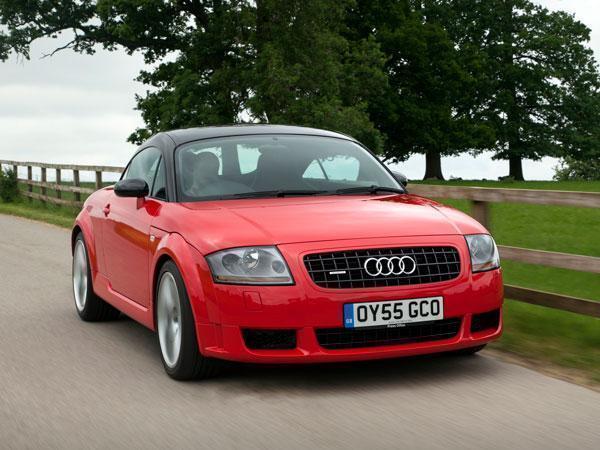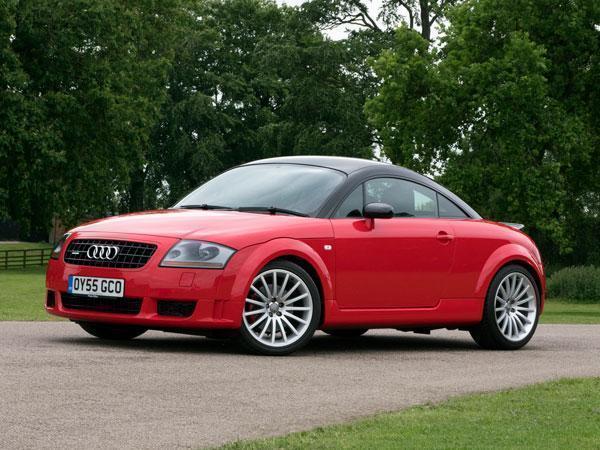Audi TT quattro Sport | PH Used Review
Lightened, two-toned Audi TT is fondly remembered. How does it stand up in 2019...

Back then...
Six years into the first generation TT's life cycle, Audi celebrated a quarter century since the first quattro was launched with the introduction of a special, limited-run model. The TT quattro Sport arrived in May 2005 with more power, a sportier chassis and a 49kg weight reduction to create the most driver-focussed model of the then seven-variant (including rag tops) line-up. While it used the smaller 1.8-litre engine, the quattro Sport's turbocharged four-cylinder motor was only 10hp short of the 250hp produced by the naturally-aspirated 3.2 V6, and with an 88kg advantage over that car, it was quicker off the mark. Moreover, at £29,360, it was £2k cheaper than the six-pot.
The worthy mix of value for money and pace helped boost the TT's appeal among enthusiasts, but even with the ditching of some hefty components (more on that shortly) the quattro Sport could do nothing about the VW Group's PQ34 architecture - a platform it shared with the poorly-received Mk4 Golf - and its kerbweight remained the wrong side of 1,400kg. Praise for it at launch was not universal.
It wasn't for lack of trying. The turbocharged engine had 240hp at 5,700rpm, a gain of 15hp over the regular model, while the removal of the back seats, parcel shelf and spare tyre left plenty of room for a rear strut brace to be added, stiffening its less than perfect structure. There were tauter springs, firmer dampers and a set of 15-spoke 18-inch cast aluminium wheels, which were mounted onto a more muscular, two-toned 3.2 body. The sporting makeover continued inside with a pair of gorgeous Recaro Pole Positions, an Alcantara-trimmed steering wheel and Quattro Sport badge badging. Few would deny it looked and felt the part.
For anyone already in the TT fan club, it was manna from heaven. But for the objective punter, it had serious competition: Renaultsport's first Megane lacked all-wheel drive and fell short on power, but it more than made up for those losses with an exciting chassis - not to mention a £5k cheaper starting price. Then there was the Nissan 350Z, a rear-driven V6 coupe that had more in common with the 3.2 TT but also cost £5k less than the quattro Sport. And when you consider that the 347hp, 5.7-litre V8-powered Vauxhall Monaro cost only £535 more than Audi's limited-run model, it's perhaps unsurprising that the 1,000-car UK quota was eventually reduced to 800.

Nowadays...
Time has been kind to the quattro Sport. Most of its rivals in 2005 have fallen into the long shadow of more interesting (or exciting) successors, but the lightened, two-toned TT has no direct follow-up to muddy the waters. Successive versions have deployed warbling five-cylinder engines, but none (aside from perhaps the 1.1-tonne TT Ultra Quattro concept of 2013) has pursued the 'purer' tactic of shedding mass. Plus, the quattro Sport looks brilliant - arguably better than it did at launch. The Mk1 TT's clean lines still look fresh and, compared to the try-hard current-gen model, nicely understated, too.
Although it was a limited-run model at the time, the Quattro Sport wasn't priced like so many of today's specials. Its original list price (£29,360) equates to about £43k in today's money, meaning it would rank only a couple of grand above the TTS. And while the present TTS has 310hp from its 2.0-litre TFSI unit and a full suite of Virtual Cockpit technology as part of its tech armoury, it's a series run model that sits amongst the range - not something special to be celebrated.
That being said, aside from the fact that the car has to be started with an actual key, it's a wholly 21st century driving experience once behind the wheel. The engine has a deep, purposeful four-cylinder tone, although it's the whistle of turbo as the boost builds that provides most of the aural entertainment - but it's genuine, non-synthesised stuff. The 1.8-litre motor is quick to respond from the off, although 2,500rpm is where its delivery jumps and the quattro Sport keeps on pushing on this consistent seam of torque all the way to 6,000rpm. It's a brilliantly elastic engine that can either lean on a meaty midrange or be revved towards its redline; both methods send the TT charging from corner to corner with unbreakable all-wheel drive traction. It's the permanent kind, too, unlike later generations that switched to Haldex hardware. The old Audi certainly doesn't feel at all dated in this regard.
It is, however, a shame that even hot Audis from the pre-EPAS era didn't offer more through the steering wheel. The resistance may very well be hydraulic-based, but there's still not much information apparent in the Alcantara-wrapped rim. This is unfortunate because the six-speed 'box has a pleasingly short throw and the pedals are placed nicely for heel-and-toe - so a more communicative steering system might have delivered the TT more convincingly into the upper echelon of noughties sports icon.
It wasn't to be, though, and anyway, the planted chassis and driveline - which enables huge cross country pace but not much more besides - pale in comparison to something like the second generation Porsche Boxster. Even in this most driver-centric of TTs you're limited to point-and-squirt; revelling mostly in the earliness at which you can get back on the throttle. An initial low-speed firmness in the upratedsuspension is superseded by something more flowing, but the 'lightweight' TT does begin to feel its weight as the pace develops. The chassis never hunkers down like you might expect (certainly not in a modern context) with crests and dips acting as a constant reminder that even this part-stripped TT carries some timber.

Should you?
The quattro Sport's foibles are relatively easy to forgive these days: nobody buys a pared-back TT expecting a plush ride or Porsche-like adjustability. What they might expect is rapid, easily accessible point-to-point performance, a proper sports car ambience and the timeless appearance of what it is unquestionably an icon. The quattro Sport nails all of that and more. Its sheer usability is reflected in the condition of those left on sale today. This was evidently no cotton-wool-wrapped special; most cars in the classifieds have fairly high mileages - none at the time of writing have less than 59k on the clock and some are well into six figures. There are signs that the quattro Sport is enjoying a bit of a resurgence, however, with 544 registered on UK roads in 2018 - a gain of seven on the year before, representing the first time the number has gone up since 2005.
Does this herald renascent classic status? Perhaps - evidently the best quattro Sports have now ticked over the £10k mark again. That leaves them around £6k below the asking price of an original TT RS so the model could be said to sit in its own bubble for now. You can get similarly tidy Mk2 Boxsters and Monaros for about the same money, or early RS Meganes for about £3k less - and remarkably, the more powerful 3.2-litre cars are even cheaper. Certainly it must be comparative rarity that keeps the quattro Sport slightly more buoyant, and - driven in 2019 - it feels deserving of its special status. Subsequent generations may have improved on the basic TT formula, but Audi's 2005 tribute to the mighty quattro was a genuine attempt at making its very pretty sports car better to drive. Nearly 15 years later, we applaud the sentiment.
SPECIFICATION | 2005 AUDI TT QUATTRO SPORT (Mk1)
Engine: 1,781cc, inline-4 turbocharged
Transmission: 6-speed manual, all-wheel drive
Power (hp): 240@5,700rpm
Torque (lb ft): 236@2,300-5,000rpm
0-62mph: 5.9 secs
Top speed: 155mph
Weight: 1,460kg
MPG: 30.4
CO2: 223g/km
Price new: £29,360
Price now: circa £8,000-10,000
Search for a Mk1 Audi TT here





The 4WD system robs the car of power so it actually only produces around 220 BHP so its slow and any attempt to extract more power from it will cost money as you have to start looking at new turbos. Forums will claim to extract 280 BHP with little cost but that's not at the wheels and the remap usually comes with a countdown timer because a large bang is sure to follow. Understeer is everywhere and again to sort this costs a significant amount of money. Then there are the brakes which will also need sorting at huge cost.
I looked at getting all the things sorted to turn it into a decent car and the bill would have been £5K+ so I sold it and bought a Z4MC for £20K
Remapped to 265hp and 280 lbf ft.
Only supporting mods are a larger intake pipe and a cone filter.
You can get to around 280 on these engines but you need an intercooler and a downpipe to do that, most tuners also recommend keeping the torque below 300 to save the rods.
Suggesting the 20vt engine is anything other than a very reliable block is UTTER nonsense. Derivatives of the same engine lived in the S3’s, golf gti’s and Ibiza/Leon cupras of that era, a very common engine but yet no real common faults ever surfaced. There is a reason these engines are transplanted into kit cars, mk1/2 golfs etc
 but the point I was trying to make was getting a true and reliable 280+ map isn't happening without spending money elsewhere and if that money isn't spent then something else will break. I underline the true because I bet there a loads of people who have paid for "280" map who a probably only getting 250 or 260 clutch. Admittedly I'm only offering experience from 8-9 years ago so mapping may have moved on since then.
but the point I was trying to make was getting a true and reliable 280+ map isn't happening without spending money elsewhere and if that money isn't spent then something else will break. I underline the true because I bet there a loads of people who have paid for "280" map who a probably only getting 250 or 260 clutch. Admittedly I'm only offering experience from 8-9 years ago so mapping may have moved on since then. Gassing Station | General Gassing | Top of Page | What's New | My Stuff



